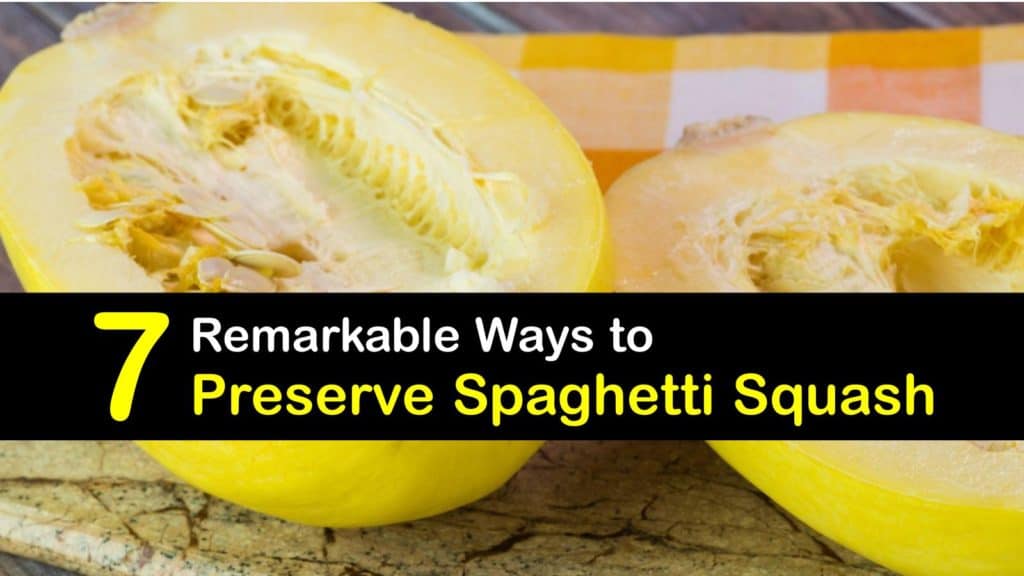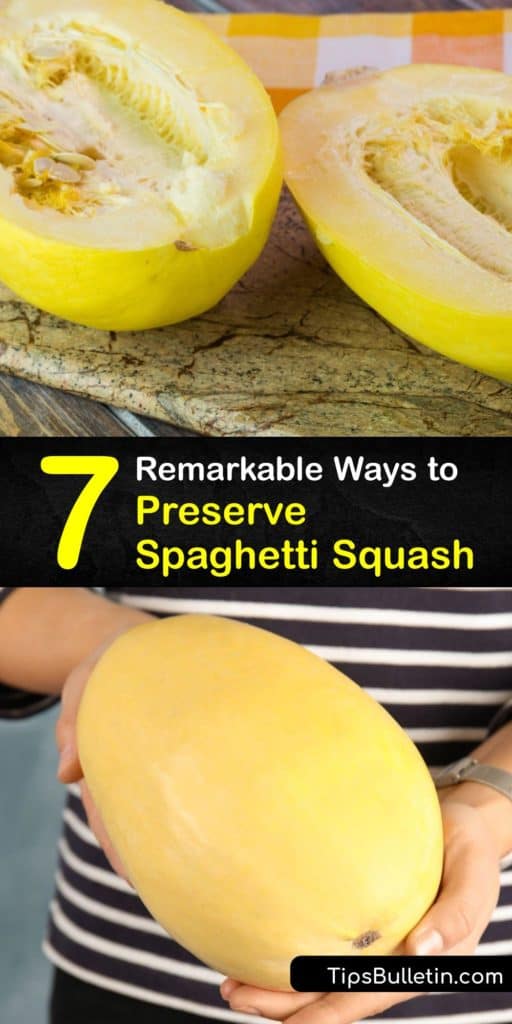It’s the end of the growing season, and you’re harvesting zucchini, butternut squash, acorn squash, and spaghetti squash from the garden. How long does spaghetti squash last after picking, and what’s the best way to store them? Discover growing and harvesting tips and how to preserve spaghetti squash in various ways.
Spaghetti squash is a winter squash, low in carbohydrates and calories and packed full of nutrients. There are a variety of spaghetti squash recipes to choose from after growing these veggies at home, from spaghetti squash casserole to spaghetti squash with marinara sauce or pesto.
With all the cooking options, it’s no wonder this squash is so popular. While this veggie stores longer than many others, it still gets old and mushy over time, especially if you don’t store it properly. Luckily, there are ways to extend the shelf life of both fresh and cooked spaghetti squash to ensure that you get more time to enjoy its tasty goodness.

Growing and Storing Spaghetti Squash
Just like other types of squash plants, planting spaghetti squash is an easy way to ensure you get tasty crops without harmful chemicals. Of course, you can always buy organic squash from the farmers market or grocery store, too.
We put together helpful winter squash gardening tips and show you how to cook spaghetti squash in a delicious recipe. Learn different ways of preserving this veggie after a good harvest by storing it at room temperature or in the fridge and freezer.
What is Spaghetti Squash?
The primary difference between gourds and squash is that most gourds are ornamental. There are many types of summer and winter squash, but what exactly is spaghetti squash? Find out what this veggie is and its flavor and texture to help you choose the right ways of preserving spaghetti squash and using it in recipes.
Spaghetti Squash
Spaghetti squash is a winter squash type with thick skin. It’s part of a group of Cucurbita pepo cultivars that grow in several sizes and shapes.

If you’re unfamiliar with this squash, its inner flesh may surprise you. Unlike other types, spaghetti squash has squash strands with a mild and neutral taste that is slightly sweet and not as strong as butternut or acorn squash.
Preserving Spaghetti Squash at Room Temperature
After you buy your squash or pick spaghetti squash from your garden, an ideal way of preserving spaghetti squash, fresh and uncooked, is to store it at room temperature. Find out where to keep this veggie in the kitchen and how to tell when it’s no longer edible.
Room Temperature Spaghetti Squash
Before storing squash, make sure you choose one that does not have blemishes or soft spots. To preserve fresh spaghetti squash at room temperature, keep it in a cool, dry area of the home where the temperature is around 60 degrees Fahrenheit.
When does spaghetti squash go bad at room temperature? Storing it this way keeps it from spoiling for up to three months. If you do not have a cool area, the kitchen or pantry is fine if you keep it away from sunshine and heat sources.
Ways to Preserve Spaghetti Squash in the Fridge
It’s essential to keep the squash in the refrigerator after cutting it open to keep it from spoiling. There are a couple of ways to preserve spaghetti squash in the fridge, and how you store it depends on whether it’s raw or cooked.
The best way to preserve spaghetti squash after cooking spaghetti squash or cutting it in half is to refrigerate it.
Wrap the cut side of the squash in plastic wrap or place the squash strands in a container and set it in the refrigerator for up to 14 days. To store cooked spaghetti squash, place it in an airtight container. Cooked squash can last in the fridge for three to five days.
Water bath canning spaghetti squash is not recommended unless you turn it into relish or pickles first.
How to Preserve Spaghetti Squash in the Freezer
One of our favorite ways to preserve spaghetti squash long-term is to keep it in the freezer. Discover how to freeze squash in a few simple steps, so you get to enjoy this healthy veggie at a later date.
Slice the squash lengthwise in half, remove the seeds, and set the two sections cut side up on a baking sheet. Bake the squash in a 375°F oven for 30 to 40 minutes until tender. Remove it from the oven and let it cool for an hour before removing the flesh.
Scrape the flesh from one side of the squash to the other with a fork to remove long strands. Put the squash strands in a colander over a large mixing bowl and set it in the fridge for 12 hours to drain.
After draining, freeze raw spaghetti squash by scooping the strands into a freezer bag, pressing out the air, and sealing it shut to prevent freezer burn. Spaghetti squash shelf life in the freezer is about eight months. When you’re ready to prepare it in a meal, take it out of the freezer and let it thaw for an hour before reheating.
Is Spaghetti Squash Easy to Grow at Home?
While spaghetti squash plants require the right amount of space to grow and some attention, they are relatively simple to grow at home. Explore a few spaghetti squash growing tips to help you get started.
Depending on the type, spaghetti squash needs anywhere from 24 to 72 inches between plants. They also love growing in full sun for about six hours or more each day and warm, fertile, well-drained soil. It’s vital to choose the right spot for your garden.
After you plant spaghetti squash, this winter squash thrives when you water it one to two inches of water each week. Black plastic mulch helps keep the ground warm and retains moisture while keeping weeds from taking over the space.
How to Use Spaghetti Squash as a Pasta Substitute
Since spaghetti squash is gluten free, low carb, and paleo friendly, it’s the perfect substitute for making spaghetti. Find out how to use this vegetable as a pasta replacement and top it with your favorite marinara sauce.
While many recipes call for cooking a whole squash in boiling water, we prefer to bake ours. Slice the squash in two by cutting it lengthwise and then remove the seeds with a spoon.
Drizzle olive oil lightly on the inside and sprinkle with salt and pepper. Place the cut sides down on a parchment-lined baking sheet and pierce the skin with a fork before baking them in an oven heated to 400°F for 30 to 40 minutes.
Once the roasted squash is cool enough to handle, use the fork tines to scrape the strands away from the rind. Put the squash strands on a plate, pour heated marinara sauce over the top, sprinkle with Parmesan cheese, and serve immediately.
Using Spaghetti Squash to Make a Casserole
Another great way to use spaghetti squash is to make a delicious casserole, and a crock pot or instant pot is not needed. This low carbohydrate, pasta-like dish has a simple meat sauce with a cheesy topping that’s hard to resist, and it serves six.
Remove the strands from a cooked spaghetti squash with a fork and set them to the side. Cook the ground beef, garlic, and onion in a medium saucepan on the stovetop until the beef is no longer pink, and drain off the fat.
Add the marinara, tomatoes, tomato paste, and seasoning and simmer for five minutes. Stir in the squash strands, pour the mixture into a casserole dish and top it with the cheese before baking it in a 375°F oven for 20-minutes. Serve immediately or refrigerate and reheat it later.
Spaghetti squash has a mild and neutral flavor, making it ideal for use in a variety of recipes. The greatest thing about this vegetable is that it’s easy to grow and can handle a variety of storage methods.

Knowing how to preserve spaghetti squash means that you get more time to enjoy the tasty health benefits of this veggie even longer, so why not share our spaghetti squash growing tips and storage methods with your friends and family on Pinterest and Facebook?